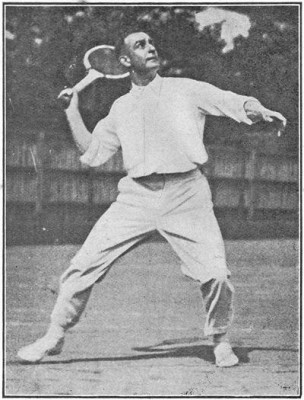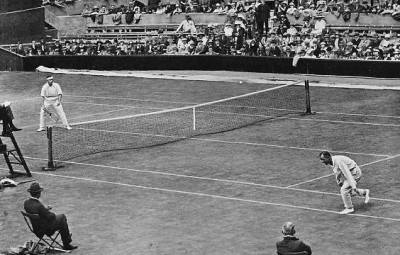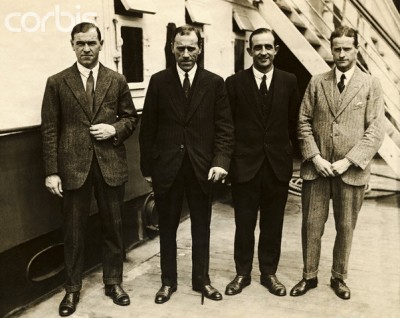To many Australian tennis fans , the name Randolph Lycett is not very well known, yet he played quite brilliant tennis for some three decades within Australia and overseas.
Which country will claim Randolph as their own? The UK seem to have a stake for he was born on the 27th of August 1886 in Birmingham England, however he arrived in Australia as a youngster with his family who became prominent in the Oil Business.
Randolph played at the top level of Australian tennis from the time he was still in his teens until the outbreak of the 1914-18 War. He then decided to remake his life in England and enjoyed a marvelous tennis career through this period also. He did play Davis Cup tennis for the British Isles and so he is often, albeit, in our view mistakenly referred to as a UK player when he really should be considered as Anglo/Australian.
A right-handed player, Randolph had an athletic physique and was on the short side in stature – being 5 ft 8 ins (173 cms) and 11 stone 5 lbs (72 kgs) when discharged from the armed forces in 1919. He retained his athleticism and a trim figure throughout his playing days.

He played for Victoria’s second team when still at school, in 1902, having recently turned 16 years of age, and was highly ranked within the State from that time onwards. Weekend to weekend, he played A Grade Pennant for the Albert Park team.
Randolph played for Victoria’s first team in four other seasons (against SA and NSW), and would have played continuously in the State’s first team from 1906 up to the onset of the War had the calls of his job not interfered.
After claiming the New Zealand men’s doubles title in 1904, when only 18 years old with H.A.Parker, Randolph won the inaugural Australasian men’s doubles in 1905 with fellow Victorian player Tom Tatchell, at the age of 19, and won that event again in 1911 with Rodney Heath – immediately after which he gained selection for Australasia’s Davis Cup team, but had to withdraw due to pressures of work.
Since he grew up here from a young child, learned his tennis here developed a business here, was married here and had children and from February 1917 to July 1919 served in the Australian army as a field gunner, I am pretty confident that Australia can stake a solid claim on Randolph Lycett.
Added to Randolph’s achievements as an Australian, after World War 1 he traveled to the UK to play at Wimbledon in 1919 and under the Australian flag played with an AIF team and toured the USA with fellow Aussies. On his first Wimbledon outing he won the Mixed Doubles with USA’s Elizabeth Ryan and came runner up in the Men’s Doubles with Rodney Heath, losing to Aussies Pat O’Hara Wood and R.V.Thomas.
In 1920, he made the quarter finals to be beaten by the eventual winner Bill Tilden and came runner up in the mixed final. Tilden was the era’s best player yet Randolph put up a great fight going down 7-5, 4-6, 6-4, 7-5 which is a mark of his tennis expertise.
In 1921, he made the quarter finals again and lost to Japanese player Shimidzu in 5 sets, won the doubles with Englishman M.Woosnan and the Mixed with Elizabeth Ryan. Of particular note was his singles match which was played on a very hot day. During the 4th set the then 35 year old Lycett organised his trainer to serve champagne between breaks since the serving of beverages was not a regular component of competitive tennis at this time. The media portray Lycett as playing under the influence for it was reported that he fell over several times twisting wildly as he went for some power shots, yet despite having two match points ended up losing in a very closely contested 10-8 5th set. It is perhaps a little unfair to say he was greatly affected by alcohol and it is more likely that rather withdrawing due to exhaustion , Randolph managed to keep himself going in an attempt to win and very nearly did. Two days later, he won the other two finals.
In 1922 he lost the singles grand final to fellow Aussie Gerald Patterson (his second Wimbledon singles title) 6-3, 6-4, 6-2 (photo left running off court), came runner up in the mixed and won the Men’s doubles with Aussie J.O.Anderson beating Pat O’Hara Wood and Gerald Patterson in an awesome 5 setter 3-6, 7-9, 6-4, 6-3,11-9.
In 1923 he made the 4th round in singles, won the mixed again with Elizabeth Ryan and won the doubles with USA’s L.A.Godfree. From 1924 to 1929 he played at Wimbledon regularly, even making the 4th round in the Men’s singles in 1926 losing against the Frenchman, Brugnon.
He amassed a quite amazing Wimbledon record from 1919 through to 1929 (age 33-43). A great effort indeed when you consider the above represents three straight Men’s doubles wins with three different partners and 5 consecutive mixed doubles finals appearances and a singles grand final in 1922.
In relation to Randolph playing Davis Cup for the British Isles, we need to step back for a moment to 1919 when Randolph left Australia to live once more in the UK. He had been charged in a Melbourne court with abandoning his Australian family from a divorce in 1914 upon returning from war service and his business interests had suffered due to a fire at the building he worked at in South Melbourne. So his move to the UK was really starting a new life one suspects.
Randolph (3rd left with) Patterson, Brookes & Rod Thomas
The English were reticent to immediately adopt Lycett into their Davis Cup Team because it was deemed to be unsportsmanlike and unfair to Australia. In 1920, Captain of the UK team Colonel A.F.Kingscote suggested writing a letter to Australia seeking approval for Lycett to join the British Team. Later that year, we presume with some agreement from Australia, the Davis Cup Committee eventually adopted a ruling to suit, allowing a player when as a “bona fide amateur shall be qualified to represent a nation if he shall be born in, be a citizen of or become a naturalised citizen of that country, or shall have resided therein for at least two years immediately preceding a tie, and when one player has represented a nation shall always be eligible for that Nation and no other”. Consequently, Randolph played his first Davis Cup match for the British Isles in 1921 as per the above ruling and therefore could not then play sometime in the future for Australia. Clearly had Randolph played for Australasia in 1911 he would not have been permitted to play for the UK. In the photo above c1919 we have Gerald Patterson, Norman Brookes, Randolph and Rod Thomas.
In England, Randolph later married Joan Austin, the sister of UK tennis great Henry “Bunny” Austin and we can only imagine enjoyed a fine lifestyle on the tennis circuit which included playing in the French Riviera.
Bunny Austin, who played a lot with Randolph in his own formative phase, summed up Randolph’s game thus:
“…his return of service was a joy to see, his overhead work the most deadly in the world. At his best he never missed. To lob him was to court disaster. His normal volley was not brilliant, but his tactics were to return the ball until his opponents either lobbed or hit the ball sufficiently high over the net for him to drive volley it. His drive volley was devastating. Our combination was good so long as they lobbed him. But when they lobbed me it was not so good.”
HW Austin: Lawn Tennis, Bits and Pieces, published in 1930.
Randolph was renowned for having a great time and tennis was the ideal vehicle to deliver a marvelous lifestyle.
He died in 1935 in Jersey aged only 49.
In 2005 a book was published after considerable research by Australian Peter Kettle. Please contact him by email pkettle@bigpond.net.au if you would like to acquire a copy or submit further information about Randolph Lycett. Tennishistory.com.au would like to thank Peter for his assistance in preparing this article.



You must log in to post a comment.